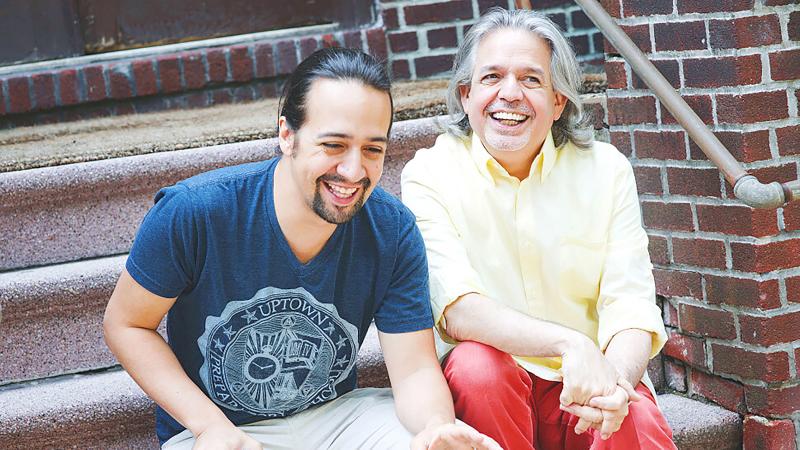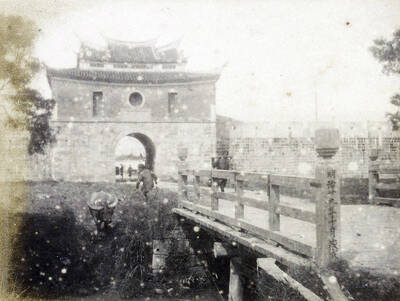For Hamilton creator Lin-Manuel Miranda, the inspirations for art and philanthropy are inextricably linked.
Miranda on Wednesday announced a series of donations to organizations that serve immigrants, whose experiences are central to the new film version of his hit Broadway musical In the Heights.
“For me,” Miranda said, “philanthropy and artistic inspiration kind of come from the same place.”

Photo: AP
He is forever drawn to what he calls “the things that don’t leave you alone.” Immigration, he said, is both a passion and a foundational element of his work.
In the Heights, he noted, centers on immigrants from the Caribbean and Latin America living in New York City. And Hamilton, he said, “is sort of the proto-immigrant story.”
“I think I am in awe of people who can make an impossible leap to leave everything they know behind and start a new life here,” he said. “And I think it’s one of the great things about our country.”

Photo: Reuters
GIVING BACK
In honor of the Fourth of July, the Miranda Family Fund awarded a total of US$225,000 in grants to immigrant rights groups and policy reform advocates throughout the country.
Luis Miranda Jr, Lin-Manuel’s father and co-founder of the MirRam Group, a political consulting firm that has worked on campaigns for Democratic Sens. Hillary Clinton, Chuck Schumer and Kirsten Gillibrand, said all the recipients were recommended by friends of the family in the field of immigration.

Photo: AP
It was important to the Mirandas to make the grants unrestricted, so the money would go to “whatever the organization believes is important,” Luis said. “It’s going to make a difference.”
“They know what they need,” Lin-Manuel added.
Though the Miranda Family Fund has been active for years in donations to the arts community, especially arts education, the donations announced Wednesday mark an expansion in its giving for immigration, which previously included working with the Hispanic Federation to establish the Immigrants: We Get the Job Done Coalition.
The fight for immigrants’ rights became a much larger part of the film version of In the Heights than it was in the musical that opened on Broadway in 2008. Lin-Manuel said the idea to make the character of Sonny a DREAMer, an undocumented immigrant who has Deferred Action for Childhood Arrivals (DACA) status, came from Quiara Alegria Hudes, who wrote the screenplay.
“Immigration was on the front page in a totally different way in the past few years,” Lin-Manuel said. “So in updating it, it sort of only made sense to make that a part of the conversation because that is part of the conversation here uptown in our communities. And so what’s so brilliant about Quiara’s choice to make Sonny struggle with his undocumented status is that he’s the most New Yorkian character. He’s the one who said, ‘If I had US$96,000, I would fix my neighborhood.’ ”
Luis added that they had that character in mind in choosing the organizations to help.
“It’s to make sure that we continue to help those organizations that are helping people like Sonny — refugees, immigrants, people who are coming and are trying to figure out how to make it here,” he said.
Lin-Manuel said that highlighting the story of an undocumented immigrant was important to him.
“I think that’s one of the things art can do that headlines can’t always do,” he said. “Now, you feel like, you know someone who’s going through this. You know Sonny, and it just it goes into your bloodstream in a different way.”
He said the donations are another way of demonstrating support.
“We’re at our best when we’re celebrating our promise. So many people come here from all over the world because of this promise that we export, and that we so often fall short of. If you work hard, there is a possibility of a better life. We want to help the organizations that help to make that possible for folks who make that journey,” he said.
STRUGGLES AND SUCCESSES
Lin-Manuel said it’s vital to showcase both the successes and the struggles of being an immigrant.
“The trick is not to look at it through rose-colored glasses, but through really clear eyeglasses,” he said. “It’s always something that we can be working on, always something we can do better.”
He holds his own work to that idea as well. The release of the movie version of In the Heights created controversy because there were no dark-skinned, Afro-Latino characters in the film’s lead roles. Lin-Manuel issued an apology and promised “to do better in my future projects.”
“Every time you make a frame, you hear from the folks who say, ‘Hey, I’m not in the frame,’” he said. “I take that learning with me to the next project. But I also know, because I live here, how proud this neighborhood is of this movie. Afro-Latinos and Latinos of every shade and how seen they feel and I can understand what I can do better next time. I’m holding space for all of it. I think that’s the only way to grow as an artist. Hamilton got criticism. Everything I do gets criticism. And I can take it and I can grow from it.”
“You have to understand I started writing In the Heights because I didn’t feel seen,” he continued. “So I am also hoping that someone is going to see In the Heights and say, ‘That wasn’t my story’ and write their own. I would be thrilled by that.”
One thing that is not on Lin-Manuel’s mind, though, is returning to Hamilton, which is set to reopen on Broadway on Sept. 14. Theorists were noticing Lin-Manuel’s longish hair recently and wondered whether he was planning a return to the Tony award-winning smash.
He’s not. And he cut off his hair to prove it, which Luis happily tweeted out.
“I have three more movies coming out this year, right?” said Lin-Manuel, referring to the animated Vivo out this summer, Disney’s Encanto this fall and his directorial debut Tick, Tick... Boom. “I don’t have the bandwidth to jump back in the show.”

June 9 to June 15 A photo of two men riding trendy high-wheel Penny-Farthing bicycles past a Qing Dynasty gate aptly captures the essence of Taipei in 1897 — a newly colonized city on the cusp of great change. The Japanese began making significant modifications to the cityscape in 1899, tearing down Qing-era structures, widening boulevards and installing Western-style infrastructure and buildings. The photographer, Minosuke Imamura, only spent a year in Taiwan as a cartographer for the governor-general’s office, but he left behind a treasure trove of 130 images showing life at the onset of Japanese rule, spanning July 1897 to

One of the most important gripes that Taiwanese have about the Democratic Progressive Party (DPP) is that it has failed to deliver concretely on higher wages, housing prices and other bread-and-butter issues. The parallel complaint is that the DPP cares only about glamor issues, such as removing markers of Chinese Nationalist Party (KMT) colonialism by renaming them, or what the KMT codes as “de-Sinification.” Once again, as a critical election looms, the DPP is presenting evidence for that charge. The KMT was quick to jump on the recent proposal of the Ministry of the Interior (MOI) to rename roads that symbolize

On the evening of June 1, Control Yuan Secretary-General Lee Chun-yi (李俊俋) apologized and resigned in disgrace. His crime was instructing his driver to use a Control Yuan vehicle to transport his dog to a pet grooming salon. The Control Yuan is the government branch that investigates, audits and impeaches government officials for, among other things, misuse of government funds, so his misuse of a government vehicle was highly inappropriate. If this story were told to anyone living in the golden era of swaggering gangsters, flashy nouveau riche businessmen, and corrupt “black gold” politics of the 1980s and 1990s, they would have laughed.

In an interview posted online by United Daily News (UDN) on May 26, current Chinese Nationalist Party (KMT) Chairman Eric Chu (朱立倫) was asked about Taichung Mayor Lu Shiow-yen (盧秀燕) replacing him as party chair. Though not yet officially running, by the customs of Taiwan politics, Lu has been signalling she is both running for party chair and to be the party’s 2028 presidential candidate. She told an international media outlet that she was considering a run. She also gave a speech in Keelung on national priorities and foreign affairs. For details, see the May 23 edition of this column,